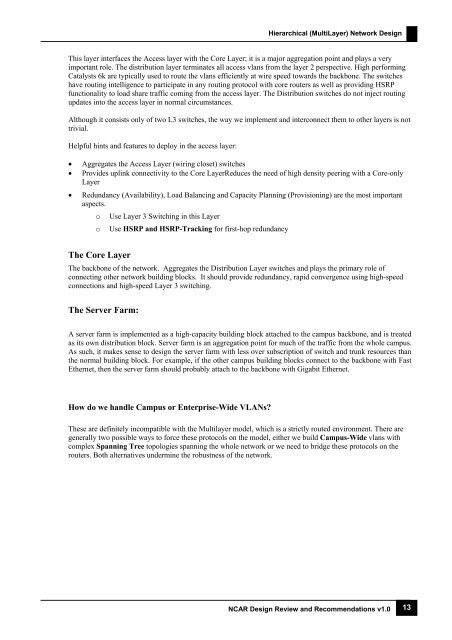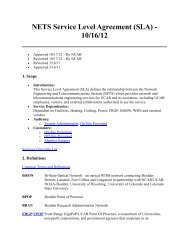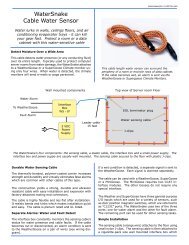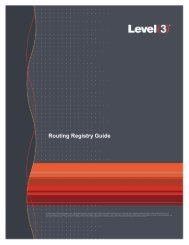Design Review Template - NETS
Design Review Template - NETS
Design Review Template - NETS
You also want an ePaper? Increase the reach of your titles
YUMPU automatically turns print PDFs into web optimized ePapers that Google loves.
Hierarchical (MultiLayer) Network <strong>Design</strong><br />
This layer interfaces the Access layer with the Core Layer; it is a major aggregation point and plays a very<br />
important role. The distribution layer terminates all access vlans from the layer 2 perspective. High performing<br />
Catalysts 6k are typically used to route the vlans efficiently at wire speed towards the backbone. The switches<br />
have routing intelligence to participate in any routing protocol with core routers as well as providing HSRP<br />
functionality to load share traffic coming from the access layer. The Distribution switches do not inject routing<br />
updates into the access layer in normal circumstances.<br />
Although it consists only of two L3 switches, the way we implement and interconnect them to other layers is not<br />
trivial.<br />
Helpful hints and features to deploy in the access layer:<br />
• Aggregates the Access Layer (wiring closet) switches<br />
• Provides uplink connectivity to the Core LayerReduces the need of high density peering with a Core-only<br />
Layer<br />
• Redundancy (Availability), Load Balancing and Capacity Planning (Provisioning) are the most important<br />
aspects.<br />
o Use Layer 3 Switching in this Layer<br />
o Use HSRP and HSRP-Tracking for first-hop redundancy<br />
The Core Layer<br />
The backbone of the network. Aggregates the Distribution Layer switches and plays the primary role of<br />
connecting other network building blocks. It should provide redundancy, rapid convergence using high-speed<br />
connections and high-speed Layer 3 switching.<br />
The Server Farm:<br />
A server farm is implemented as a high-capacity building block attached to the campus backbone, and is treated<br />
as its own distribution block. Server farm is an aggregation point for much of the traffic from the whole campus.<br />
As such, it makes sense to design the server farm with less over subscription of switch and trunk resources than<br />
the normal building block. For example, if the other campus building blocks connect to the backbone with Fast<br />
Ethernet, then the server farm should probably attach to the backbone with Gigabit Ethernet.<br />
How do we handle Campus or Enterprise-Wide VLANs<br />
These are definitely incompatible with the Multilayer model, which is a strictly routed environment. There are<br />
generally two possible ways to force these protocols on the model, either we build Campus-Wide vlans with<br />
complex Spanning Tree topologies spanning the whole network or we need to bridge these protocols on the<br />
routers. Both alternatives undermine the robustness of the network.<br />
NCAR <strong>Design</strong> <strong>Review</strong> and Recommendations v1.0 13













